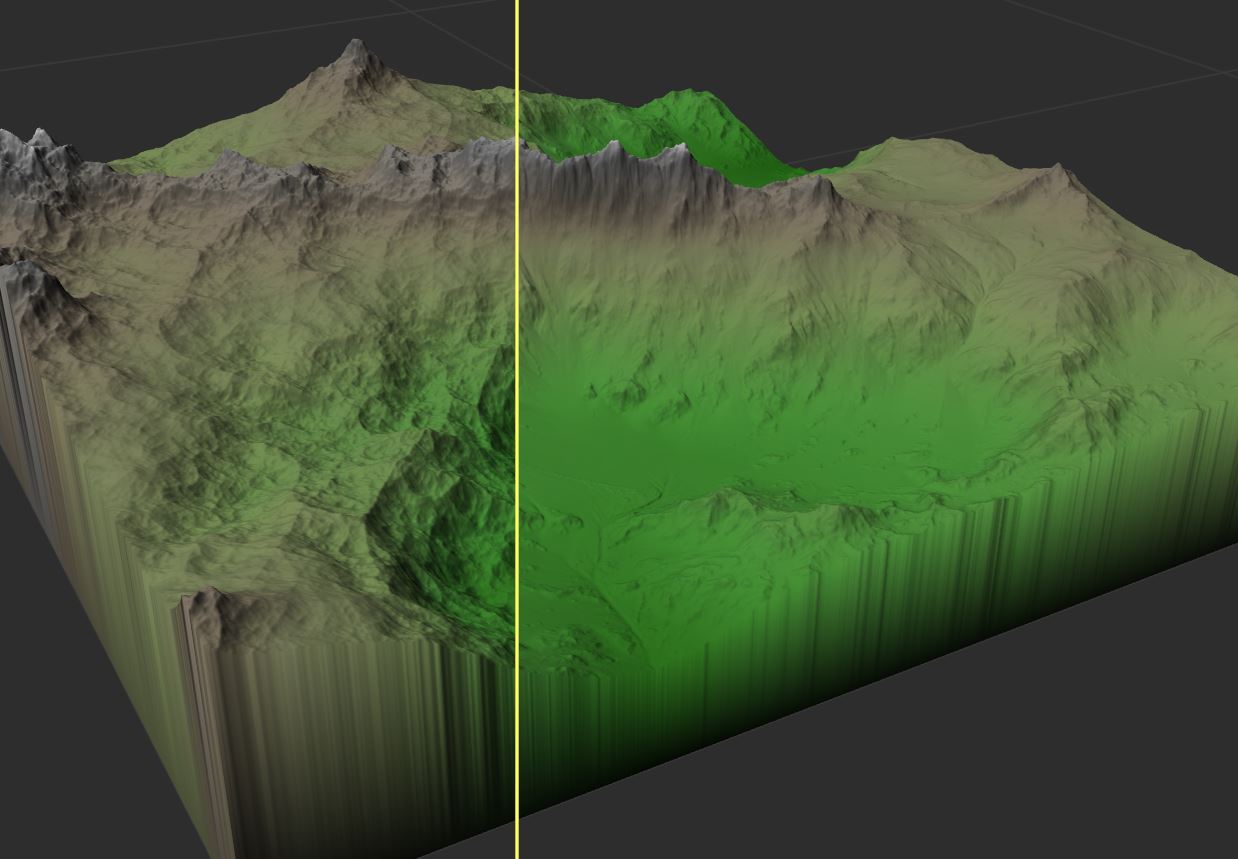Erosion『侵蚀』
Erosion节点通过模拟数千年甚至数百万年的雨水冲刷与水流作用,对地形进行侵蚀效果处理。这是为人工创建地形增添细节与真实感的绝佳工具,几乎适用于所有World Machine工程。

Erosion也可用于地形纹理处理。通过使用标识磨损、沉积和水流区域的遮罩,您能创建出比常规高度坡度分布更富趣味的纹理效果。
节点参数
Erosion节点包含大量参数,各参数间相互作用可产生独特效果。建议通过自定义参数或使用预设方案进行实验,可创造出截然不同的侵蚀强度与形态。
基础参数
以下为地形侵蚀最核心的调节参数:
- 侵蚀持续时间
模拟侵蚀作用的时间长度。数值越高处理时间越长,建议使用能产生满意效果的最小值以保证性能。 - 岩石硬度
基岩抗侵蚀能力。高值虽会减弱整体侵蚀效果,但能雕刻出更深/更陡峭的沟壑。 - 沉积物携带量
水流携带沉积物的能力。高值将增强侵蚀作用并增加谷底沉积。 - 过滤类型
侵蚀过程中的地形平滑处理方式:- 无过滤 - 产生锐利粗糙的侵蚀特征
- 简单过滤 - 形成圆润扩散的土壤覆盖型山坡
- 反向过滤 - 增强侵蚀特征陡峭度,适用于冰川侵蚀地貌
- 过滤强度
控制所选过滤类型的应用强度
地质时间增强
该功能显著增强侵蚀效果而无需超长模拟时间,可使山脉快速崩解为碎石。

- 侵蚀时间增强器
控制效果强度(0.0时等同于常规侵蚀,数值越高效果呈指数级增强) - 地形重建类型:
- 快速(线性山脊) - 处理快速但可能产生轴向伪影
- 优质(平滑山脊) - 平滑融合新旧特征,减少方向伪影但耗时较长
- 地质抬升
控制地质时间内的地形抬升量(需配合遮罩或水渠输入才能完全发挥作用)
仅在地质时间增强启用时生效 - 遮罩结构输出
控制侵蚀纹理遮罩的细节程度:
低值呈颗粒状小范围效果,高值则全局平均化处理
仅在地质时间增强启用时生效
渠化侵蚀参数
(需启用渠化侵蚀时生效)用于雕刻特征性沟壑与山脊:
- 侵蚀类型
- 标准侵蚀 - 产生风化特征但无深沟
- 渠化侵蚀 - 加深并雕刻额外沟壑
- 沟壑深度
控制沟壑雕刻深度 - 后侵蚀处理
设定渠化作用后的二次侵蚀百分比,使效果更自然
兼容性选项
(通常新工程无需调整)用于保持与旧版本一致性:
- 保留地图边界
勾选后地图边缘不受侵蚀影响,配合抬升参数可形成边缘稳定效果:
- 硬度不影响沟深
勾选后岩石硬度不影响渠化侵蚀深度(WM 2的默认设置)
输入/输出端口
输入端口
- 硬度遮罩(高度场)
调节岩石硬度的遮罩(1.0表示当前硬度,0.0表示最低硬度) - 水渠输入(高度场或水体数据类型)
标识水道区域(该区域不受侵蚀并作为沉积汇)
输出端口
- 水流遮罩 - 显示水流作用区域
- 磨损遮罩 - 显示基岩侵蚀区域
- 沉积遮罩 - 显示沉积作用区域
Erosion与Water
当输入水文系统时,侵蚀会将其作为沉积汇处理(预设水体具有无限沉积携带能力),近水区域因沉积减少而侵蚀加剧。

对已存在河流的地形进行大规模侵蚀时,建议启用地质抬升以维持河谷形态。
最佳实践与注意事项
性能优化
Erosion是World Machine最耗时的处理模块,建议使用最小有效侵蚀时长,并限制节点使用频率。
分块处理
分块构建可能产生差异,可通过项目设置→分块设置→增大混合尺寸改善。
相关链接
- Thermal Weathering
- Texturing
- Water in World Machine

